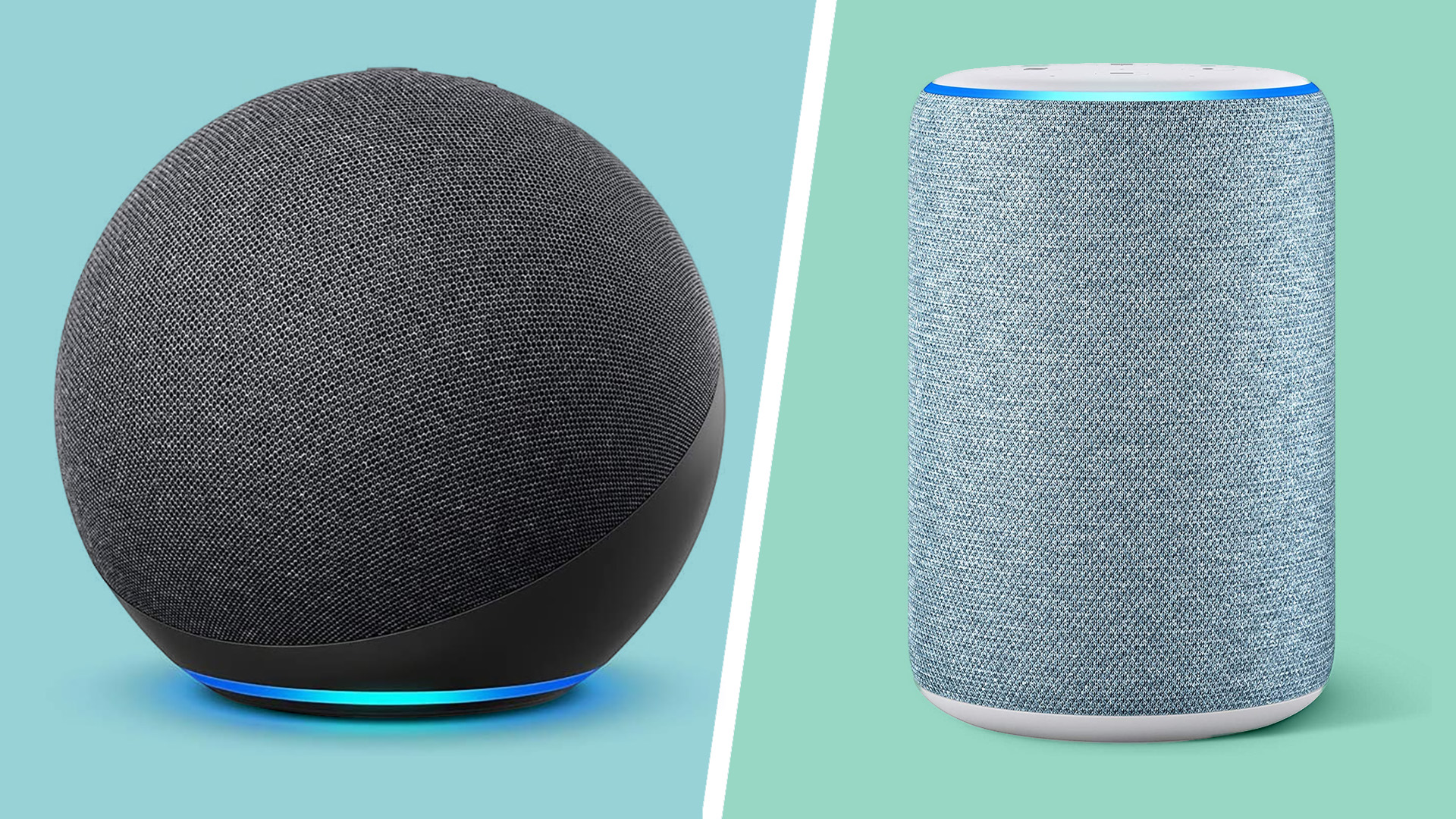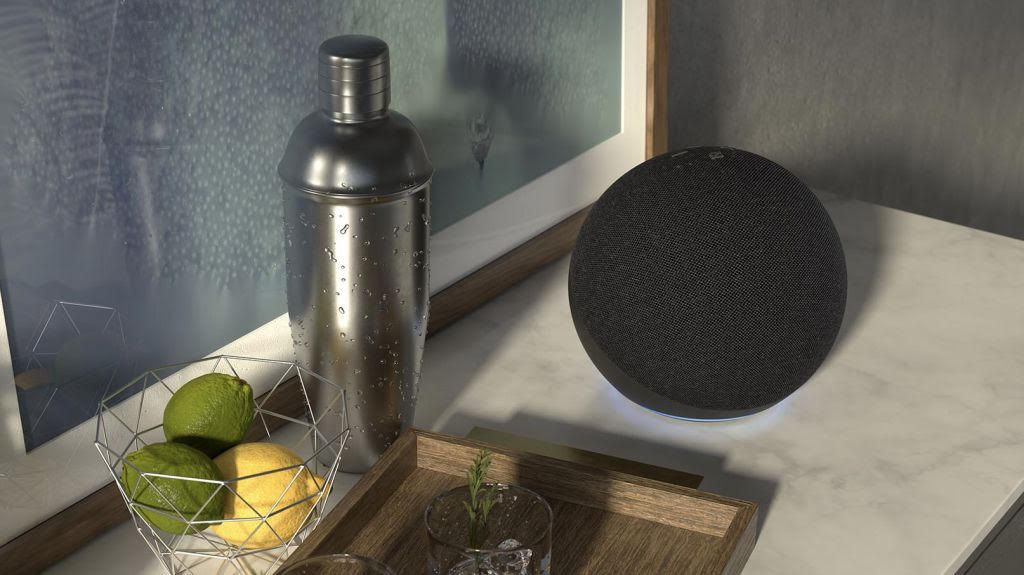Amazon Echo (2020) vs Amazon Echo (2019)
Amazon added a stack of features to its 2020 Echo smart speaker

Amazon announced the refresh of its Echo range in September 2020. The Echo 4th Generation replaced the 3rd Generation, released a year earlier.
It’s no quick and easy refresh. Almost every part has been tweaked or changed.
The Amazon Echo 4th Generation has a different shape, a new processor, better hardware for smart home tech fiends and a different driver array. 360-degree audio is traded in for Dolby Digital stereo, a good swap unless you want to place your Echo right in the middle of the room and have it fire out in sound all directions.
For most of us, this is a no-brainer. The Amazon Echo 4th Generation gets you better tech at around the same price. And, well, the 3rd Generation Echo will be discontinued anyway, making the decision even easier.
Don’t rule out the older speaker if you see it selling at a discounted price, but otherwise stick to the new model.
FAQ
Why you can trust TechRadar
What is an Echo speaker?
Echo is the name given to Amazon’s smart speakers. Some have screens, some don’t. They cover all ground from the tiny box designed to let you control your smart lights, to the hifi-style Echo Studio. Alexa joins them all up. This is Amazon’s digital assistant, the artificially intelligent pseudo-person who responds when you talk to the speaker. The standard Echo speakers are a good fit more most. They’re not too big, not too expensive, and yet still sound good.
What can an Echo do?
If the Amazon Echo will be your first smart home gadget, you might want to try asking it to play some specific songs, ask for a weather report or to set a timer. That last one is perfect as a cooking aid. An Echo gets even more interesting when you buy some other smart home tech, like a smart light. You can control the vast majority of gadgets like that with any Echo.
What’s the difference between an Echo, a Dot and a Show?
The standard Echo, the Echo Dot and the Echo Show are the three main lines of the Amazon smart speaker family. Echo Shows have screens, Echo Dots are cheap and small, and standard Echos had a design closest to the original Amazon tower speaker, until this year. More on that below. There are others, like the Echo Spot, Auto and Studio, but the three main lines are a good place to start if you’re new to smart speakers.
How is an Alexa speaker different than a Bluetooth speaker?
A portable Bluetooth speaker is a great way to get music on-the-go. They have batteries, the Amazon Echo (2020) does not because it’s made to stay at home. It does have Bluetooth too, but mostly operates using your home Wi-Fi network.

Amazon Echo (2019)
The 2019 Amazon Echo arrived in September 2019. It was already a familiar design back then.
It’s a relatively petite cylindrical tower speaker decked out in fabric, for a soft living room-ready look. 148mm tall and 99mm diameter, it won’t dominate a room.
Fans of the Amazon Echo range may note it looks almost exactly like the Echo Plus, but there are some important differences. The Echo 3rd Generation does not have Zigbee connectivity. Amazon’s 4th Generation model does, so read on to find out what it does.
The Echo 3rd Generation has two audio drivers, and they provide good sound for a $99.99 smart speaker. There’s one 3-inch bass driver and a single smaller tweeter. But the way they are arranged is the most interesting factor here.
Its bass driver points downwards and the tweeter points upwards. Both are directed at diffuser rings, which spread the sound out from all sides. The idea is you could place the Echo 3rd Generation in the centre of a table and it will deliver sound at 360 degrees.
The newer model takes a completely different approach.
Amazon’s older Echo 3rd Generation is easy to use, looks inoffensive, and while it doesn’t have every feature Amazon offers, it does have one we like a lot. A 3.5mm socket on the back can be configured to act as an input or output, which dramatically opens up what you can do with it.
Want to play music from another source, or hook it up to a big home Hi-Fi for better sound quality? No problem.

Amazon Echo (2020)
We half expected Amazon to simply tweak the Echo for 2020, but this is a complete redesign. It looks nothing like the 3rd generation speaker.
Its ball-like shape is nothing new for Amazon, though. It started playing around with round devices in 2017 with the Echo Spot. But the Echo 4th Generation is significantly larger.
At 133mm tall and 144mm wide, the Echo 4th Generation is shorter than the 3rd Generation Echo, but will need a bit more space on a table or bookshelf. We think it looks significantly more striking, with some of the designer flavour you get from companies like B&O.
The Amazon Echo 4th Generation will work best when position at the side of the room rather than at its centre. We imagine Amazon found this was how most people used the 3rd Generation anyway.
Instead of using a diffuser ring to provide 360-degree sound, the Echo 4th Generation takes a much more traditional, directional approach. There’s a 3in bass driver that points slightly upward, and two tweeters below, angled to deliver a fairly wide — but not 360-degree — cone of sound.
Even if the drivers are the same as last time, we’re likely to get a significant improvement to the soundstage. The two higher frequency drivers let the Echo 4th Generation play stereo sound, where the older version was a pure mono speaker.
From our years of testing we’d always pick a stereo setup over a mono one of the same quality. Songs almost always sound more dynamic and involving.
There are other technical improvements. The 2020 Echo 4th Generation has Zigbee support. This is a communication standard that you can think of an alternative to Wi-Fi. But in practice it means you can control things like Philips Hue lights without needing to install the Hue app on your phone.
Lots of smart home gadget manufacturers support Zigbee, including Samsung, IKEA, Hive, Belkin and Yale. If you’re planning on tooling up your house with smart gadgets, you probably want Zigbee. It’s not a big consideration if you are not.
The Echo 4th Generation also supports Amazon’s new Sidewalk feature. This uses Bluetooth as an alternative method of communication for your smart gadgets. And as each Sidewalk device acts like a node in a mesh network, this could end up being a powerful feature.
Still, if you just want a way to ask for playlists and to try out Alexa, you don’t need to worry about Sidewalk.
There’s one final techie improvement. The 2020 Amazon Echo has a new “AI” processor called the AZ1 Neural Edge. This processes your commands before they are sent to Amazon’s computers in the cloud to work out what you are trying to say. Amazon says this results in faster responses from Alexa, cutting the lag by a few hundred milliseconds each time.
Sure, that won’t earn you an extra hour’s sleep each night, but we’re always game for a more responsive digital assistant.
The Echo 4th Generation is available to pre-order and will ship from 22 October. It comes in three colors: twilight blue, charcoal, glacier white. And at the time of writing it comes with a Philips Hue bulb worth around $20 on is own.
Verdict
There’s little reason to buy the 2019 3rd Generation Echo nowadays unless you don’t like the spherical design of the 2020 version, you find the oldie dirt cheap or you’re desperate to have a smart speaker with 360-degree audio, so you can place in the middle of a large table.
Amazon’s 4th generation Echo has more directional stereo sound, for a more engaging listen, and more tech inside. It has Zigbee, making the new model a better smart home hub than the old one. And Amazon Sidewalk support, which may become a big part of the wider Echo system’s future.
Owners of the Echo 3rd Generation don’t need to head to eBay to offload their older smart speaker, stat. But if you have $100 / £90 / £150 to spend on an Alexa smart speaker, buy the 2020 4th Generation Echo.
- Find all the lowest Amazon product prices in our Prime Day deals guide
Sign up for breaking news, reviews, opinion, top tech deals, and more.

Andrew is a freelance journalist and has been writing and editing for some of the UK's top tech and lifestyle publications including TrustedReviews, Stuff, T3, TechRadar, Lifehacker and others.